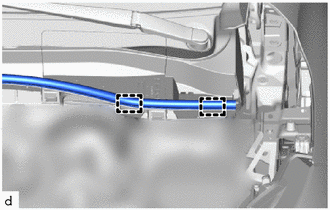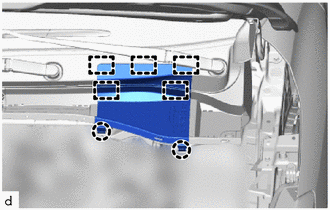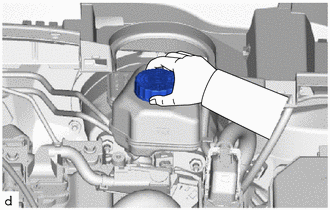Toyota Corolla Cross: Bleeding
BLEEDING
CAUTION / NOTICE / HINT
The necessary procedures (adjustment, calibration, initialization, or registration) that must be performed after parts are removed and installed, or replaced during brake fluid bleeding are shown below.
HINT:
When the cable is disconnected/reconnected to the auxiliary battery terminal, systems temporarily stop operating. However, each system has a function that completes learning the first time the system is used.
- Learning completes when vehicle is driven
Effect/Inoperative Function When Necessary Procedures are not Performed
Necessary Procedures
Link
Front camera system
Drive the vehicle straight ahead at 15 km/h (10 mph) or more for 1 second or more.
.gif)
- Learning completes when vehicle is operated normally
Effect/Inoperative Function When Necessary Procedures are not Performed
Necessary Procedures
Link
Power door lock control system
- Back door opener
Perform door unlock operation with door control switch or electrical key transmitter sub-assembly switch.
.gif)
Power back door system
Fully close the back door by hand.
HINT:
Initialization is not necessary if the above procedures are performed while the back door is closed.
.gif)
Air conditioning system
After the ignition switch is turned to ON, the servo motor standard position is recognized.
-
CAUTION / NOTICE / HINT
NOTICE:
- Move the shift lever to P and apply the parking brake before bleeding the brakes.
- Add brake fluid to keep the level between the MIN and MAX lines of the reservoir while bleeding the brakes.
- If brake fluid leaks onto any painted surface, immediately wash it off.
- Do not operate the brake actuator assembly while air is in the brake system or in the brake master cylinder sub-assembly. Doing so may cause air to enter the brake actuator assembly.
- If bleeding the brake actuator assembly is difficult due to air in the brake actuator assembly, replace it with a new one.
- Do not operate the brake pedal with the bleeder plug of 2 or more wheels open.
HINT:
If any work is performed on the brake system or if air in the brake lines is suspected, bleed the air from the brake system.
PROCEDURE
1. PRECAUTION
NOTICE:
After the ignition switch is turned off, there may be a waiting time before disconnecting the negative (-) auxiliary battery terminal.
Click here .gif)
2. DISCONNECT CABLE FROM NEGATIVE AUXILIARY BATTERY TERMINAL
Click here .gif)
3. REMOVE CENTER COWL TOP VENTILATOR LOUVER
|
(a) Disengage the 2 hooks and separate the hood to cowl top seal from the cowl top ventilator louver sub-assembly. |
|
|
(b) Disengage the 2 claws and 5 guides to remove the center cowl top ventilator louver from the cowl top ventilator louver sub-assembly. |
|
4. REMOVE BRAKE MASTER CYLINDER RESERVOIR FILLER CAP ASSEMBLY
|
(a) Remove the brake master cylinder reservoir filler cap assembly. |
|
5. FILL RESERVOIR WITH BRAKE FLUID
(a) Add brake fluid to the reservoir until the fluid level is between the MAX and MIN lines on the brake fluid reservoir.
Brake Fluid:
SAE J1703 or FMVSS No. 116 DOT3
SAE J1704 or FMVSS No. 116 DOT4
NOTICE:
- Make sure that there is sufficient brake fluid in the reservoir.
- Do not remove the filter from the brake master cylinder reservoir assembly and be sure to fill the brake master cylinder reservoir assembly with new brake fluid to avoid any potential contamination of the brake system. Contamination, for example by dirt particles or mineral oil, could lead to functional brake problems.
HINT:
When replacing the brake fluid, the brake fluid bottle can be inverted and placed on the reservoir filler opening.
6. BLEED BRAKE LINE
(a) Remove the bleeder plug cap.
(b) Connect a vinyl tube to the bleeder plug.
(c) Depress the brake pedal several times, and then loosen the bleeder plug with the pedal depressed.*1
NOTICE:
- Add brake fluid to keep the level between the MIN and MAX lines of the reservoir while replacing the brake fluid.
- Do not operate the brake pedal with the bleeder plug of 2 or more wheels open.
(d) When fluid stops coming out, tighten the bleeder plug and release the brake pedal.*2
(e) Repeat steps *1 and *2 until all the air in the brake fluid is completely bled out and new brake fluid comes out.
(f) Tighten the bleeder plug completely.
Torque:
8.3 N·m {85 kgf·cm, 73 in·lbf}
(g) Install the bleeder plug cap.
(h) Repeat the above steps to bleed the brake fluid of the brake lines for each wheel.
7. INSPECT FOR BRAKE FLUID LEAK
8. ADJUST BRAKE FLUID LEVEL IN RESERVOIR
Click here .gif)
9. INSTALL BRAKE MASTER CYLINDER RESERVOIR FILLER CAP ASSEMBLY
(a) Install the brake master cylinder reservoir filler cap assembly.
10. INSTALL CENTER COWL TOP VENTILATOR LOUVER
(a) Engage the 5 guides and 2 claws to install the center cowl top ventilator louver to the cowl top ventilator louver sub-assembly.
(b) Engage the 2 hooks to install the hood to cowl top seal to the cowl top ventilator louver sub-assembly.
11. CONNECT CABLE TO NEGATIVE AUXILIARY BATTERY TERMINAL
Click here .gif)
12. INITIALIZATION AFTER RECONNECTING AUXILIARY BATTERY TERMINAL
HINT:
When disconnecting and reconnecting the auxiliary battery, there is an automatic learning function that completes learning when the respective system is used.
Click here .gif)





